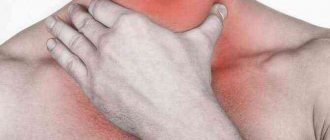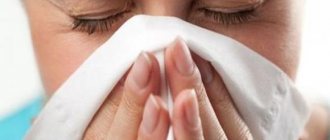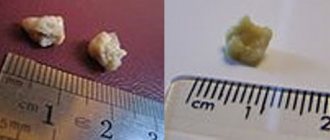What is considered normal
In healthy people, the epithelium of the respiratory tract is covered with mucus (tracheobronchial secretion). It is secreted by glands located in the mucous membrane. Functions of slime:
- protects the mucous membrane from drying out, irritation and injury;
- kills pathogens;
- has a cleansing effect - ensures the removal of very small foreign particles, metabolic products of epithelial cells and other unnecessary substances.
The volume of secretion secreted by the epithelium of the respiratory tract ranges from 10 to 100 ml per day. A healthy person simply swallows these secretions.
https://youtu.be/https://www.youtube.com/watch?v=DX8wUmnr1sE
_
Symptoms
Sputum is mucus that is secreted by glandular cells of the trachea, nasal cavity, paranasal sinuses and bronchi. Normally, no more than 100 ml of mucus accumulates in the tracheobronchial tree per day. It has bactericidal properties and is involved in the removal from the respiratory tract:
- dust;
- allergens;
- pathogenic agents.
When the mucous membrane is irritated, the activity of glandular cells increases 10 times or more.
Therefore, in case of illness, up to 4 liters of pathological sputum are produced per day. Expectoration of mucus without coughing is a nonspecific symptom that accompanies pathologies of various systems:
- respiratory;
- digestive;
- endocrine;
- nervous.
To find out the cause of the condition, you need to determine:
- the nature of sputum - elasticity, transparency, color, smell;
- associated symptoms – chest pain, sore throat, burning sensation in the nose;
- factors that provoke exacerbation are strong odors, physical activity, drinking hot drinks, etc.
Expectoration of mucus without coughing in half of the cases indicates damage to the nasopharynx or bronchopulmonary system.
Sinusitis and rhinitis
Thick mucus is released without coughing in case of inflammation of the nasopharynx and paranasal sinuses. Copious sputum is expectorated in the following diseases:
- Rhinitis (runny nose). Inflammation of the nasal mucosa is accompanied by the secretion of viscous mucus. Its transparency and elasticity depend on the form of the disease. An infectious runny nose produces yellow or green mucus. In people with insufficient tone of blood vessels, vasomotor rhinitis occurs, in which a transparent secretion is formed. With atrophic rhinitis, foul-smelling green sputum occurs.
- Sinusitis. When the maxillary sinuses become inflamed, sinusitis occurs, the ethmoid sinuses - ethmoiditis, the sphenoid sinuses - sphenoiditis, and the frontal sinuses - frontal sinusitis. If you cough up white, thick mucus without coughing, the cause of the illness is a viral infection or allergy. With bacterial and fungal inflammation, it acquires a yellow or green tint and an unpleasant odor.
Expectoration of mucus without coughing occurs mainly in the morning, as during the night it flows down the back wall of the throat into the hypopharynx.
Phlegm in the throat without cough in children and adults occurs due to inflammation:
- palatine tonsils – tonsillitis;
- pharynx – pharyngitis;
- larynx - laryngitis.
If the secretion is transparent, this indicates the onset of the disease or the attenuation of inflammation. In the absence of complications, the cough does not bother you, and small amounts of sputum are expectorated. If it becomes thick and green, purulent inflammation is possible.
Reflux esophagitis
If there is no cough, but there is sputum in an adult, the cause may be the reflux of gastric contents into the esophagus - gastroesophageal reflux disease (GERD). Gastric juice contains hydrochloric acid, which irritates the mucous membrane and provokes the production of mucus.
GERD manifests itself:
- heartburn;
- sour taste in the mouth;
- swallowing disorder;
- hoarseness of voice;
- heaviness in the stomach after eating.
GERD is characterized by insufficiency of the esophageal sphincter.
The contents of the stomach enter the esophagus when the body is tilted or in a supine position. Therefore, clear mucus is coughed up after waking up. If you accidentally inhale gastric juice, a spasmodic cough occurs, accompanied by a burning sensation in the laryngopharynx.
Viscous mucus accumulates in the respiratory tract during infectious inflammation of the bronchi and lungs. Green sputum occurs when the ENT organs are damaged:
- Koch's bacillus;
- adenovirus;
- Staphylococcus aureus;
- pneumococcus;
- coronavirus;
- measles virus;
- peptostreptococcus;
- pyogenic streptococcus;
- corynebacterium.
Pathogenic microorganisms produce toxins, so signs of intoxication (poisoning) come to the fore:
- weakness;
- lack of appetite;
- headache;
- drowsiness;
- sweating
If there is no cough and mucus accumulates in the bronchi, breathing becomes harsh. When listening with a stethoscope, moist rales are heard in the lungs.
Allergy
Sputum production without coughing is one of the signs of a respiratory allergy. Irritants (allergens) are:
- medicines;
- plant pollen;
- Food;
- fumes from household chemicals;
- dust mites.
Manifestations of respiratory allergies:
- labored breathing;
- redness of the throat mucosa;
- nasal congestion;
- lacrimation (with hay fever);
- pain when swallowing;
- hoarseness of voice.
Depending on the location of the inflammation, the allergy occurs with or without a cough.
Patients complain of expectoration of clear, viscous sputum, which sometimes becomes glassy. In the absence of treatment, the clinical picture is supplemented by new symptoms - spasmodic cough, shortness of breath, swelling of the mucous membranes.
Bronchitis
With inflammation of the bronchi, the production of bronchial secretions increases 5-7 times. At the initial stage, the cough appears and then disappears. When accumulated mucus irritates the receptors, coughing attacks occur. Without taking mucolytics, she does not expectorate, so wheezing appears in the lungs.
Symptoms of bronchitis:
- malaise;
- hard breathing;
- chest discomfort;
- nasal congestion;
- moderate increase in temperature.
Sjögren's syndrome
Sputum without fever and cough is one of the signs of Sjögren's disease. It is characterized by damage to connective tissue and exocrine glands. Accompanied by sinusitis and tracheobronchitis, separation of rusty sputum.
Symptoms of Sjögren's disease:
- muscle and joint pain;
- dry eyes;
- seizures in the corners of the mouth;
- violation of the act of swallowing;
- prostration;
- dry tongue;
- formation of crusts in the nose;
- enlargement of the parotid glands.
The mucous membrane of the throat dries out and acquires a bright red tint. If the glands are insufficient, the saliva becomes viscous.
Due to dysphagia (impaired swallowing), the patient cannot swallow it. Therefore, there is a feeling of mucus accumulation in the throat.
Sputum without cough in a child appears against the background of adenoiditis. This is the name for inflammation of an enlarged nasopharyngeal tonsil. The adenoids block the nasal passages, so viscous secretions accumulate in the nasal cavity. During sleep, it flows into the throat through the back wall of the pharynx.
Manifestations of adenoiditis:
- night snoring;
- violation of nasal breathing;
- coughing up yellow mucus;
- restless sleep;
- headache;
- elevated temperature.
There is no cough while awake. It occurs in the morning or immediately after waking up due to irritation of the throat by nasal secretions. If left untreated, the Eustachian tube becomes inflamed (eustachitis), so the child complains of decreased hearing acuity and ear pain.
Esophageal diverticulum
An esophageal diverticulum is a saccular bulge in the wall of the esophagus. It manifests itself as dysphagia, bad breath, and a feeling of a lump in the throat. Many people experience hypersalivation - excessive production of saliva, so they complain of copious sputum discharge without coughing attacks.
Associated symptoms depend on the location of the diverticulum. The most striking clinical picture when a protrusion forms in the clavicle area:
- change in voice timbre;
- nausea;
- scratching in the throat;
- expectoration of thin sputum;
- regurgitation of food;
- backflow of mucus from the esophagus into the throat.
Large diverticula put pressure on the respiratory system, causing coughing. It is combined with chest pain and dizziness.
Consequences of smoking
Non-infectious bronchitis is a problem faced by smokers with more than 7 years of experience. Systematic damage to the bronchi by tobacco smoke leads to irritation and inflammation of the mucous membrane, which increases the activity of glandular cells.
Symptoms of smoker's bronchitis:
- rawness in the throat;
- occasional cough;
- mucus department;
- dyspnea;
- hard breathing;
- tachycardia (against the background of coughing attacks).
During the day, sputum passes without coughing. But during sleep, it accumulates in the throat, so in the morning coughing attacks occur, during which clots of transparent mucus are released.
Worm infestation
If a child or adult does not cough up clear or white sputum, the cause may be helminthiasis. In the acute phase, parasite larvae circulate in the blood and enter the bronchi. They irritate the mucous membrane, causing a productive cough. A person complains about:
- chest pain;
- swelling of the mucous membranes;
- shortness of breath;
- nausea.
When the mucus is swallowed, the worms enter the intestines, where they develop into adults. In the later stages, helminthiasis manifests itself:
- abdominal pain;
- unstable stool;
- weakness;
- sleep disturbance;
- elevated temperature;
- convulsions.
With a chronic disease, immunity decreases, so rhinitis, tracheitis, and influenza often recur.
Other reasons
Foul-smelling mucus without coughing is a dangerous symptom that occurs against the background of purulent inflammation of the ENT organs. Without treatment, complications are possible - abscess and gangrene of the lung, sepsis (blood poisoning).
Possible causes of expectoration:
- lungs' cancer;
- pulmonary syphilis, disintegration of syphilitic gum;
- bronchopulmonary carcinoma;
- cystic fibrosis;
- pulmonary mycosis;
- actinomycosis;
- bullous disease;
- pleural empyema;
- COPD
Mucus or snot is accompanied by certain symptoms. Among them the following stand out.
- Runny nose.
- There is a feeling of a lump in the throat.
- Discomfort when swallowing.
- The urge and the cough itself.
- Chills and aches.
- Sometimes headaches.
There is no need to worry if you experience a mild feeling of mucus in your throat. How to get rid of it in this case? Simple methods will help (rinsing, taking herbal decoctions, inhalation, etc.). After all, sputum is a filter that protects against further entry of microbes into the body. This is how the immune system reacts to the increased intake of viruses and microbes inside.
Symptoms of the disease:
In addition to the secreted mucus, there are other alarming symptoms for these diseases - runny nose, cough, fever, general weakness, breathing problems. Mucus itself does not affect our health, but if left untreated, it can lead to bronchial congestion. This, in turn, causes secondary respiratory infections.
And breathing, when nothing interferes with it, is much more pleasant than constantly coughing up your throat. An adult does not find anything good from a tickling throat, hoarseness, change in voice, or problems with breathing. Getting rid of a boring problem, I want it faster. Sometimes it seems that we produce an endless amount of mucus! Let's try to find a method to get rid of the problem together.
A lump of mucus in the throat: how to get rid of symptoms in an adult:
Although phlegm in the throat is usually associated with a cold, it is often a symptom of many serious illnesses.
Always seek help from doctors:
- If you notice mucus colored red or pink.
- Look closely and you can see a small amount of blood in it.
- This may indicate pneumonia, tuberculosis, or other serious respiratory illnesses.
- In some cases, examination may reveal much more serious diseases.
- In such a situation, you should take the prescribed x-ray and not panic.
- No less dangerous is the black color of mucus - this is a sign of a polluted environment, or you have chronic sinusitis.
- Yellow or brown discharge is usually caused by harmful substances found in cigarettes or processed foods.
- If the sputum is yellow or green, do not worry too much - this is due to an infection that our body is fighting.
- It’s really bad if your baby suffers.
Mucus in a child’s throat, how to relieve suffering:
Even if it’s not on the topic of today’s article, after all, children are not adults. There is no strength in watching them cry. I would advise mothers who don’t know what to do in these cases. Naturally, only harmless advice. For serious treatment, see a doctor!
When there is a lot of mucus production, hydration is very important. Excess secretions usually cause a wet cough, which is very irritating to the throat. To help ease the airways, give your child plenty of fluids. You can give tea with honey or onion syrup. If your child often suffers from throat discharge, it is worth checking his health.
Recurrent cough leads to the so-called croup. This means that inflammation affects the larynx and trachea, making breathing difficult. At such times, it is better to take the child out into the fresh air. You need to buy a good inhaler. Regular cleaning of the nose is very important for the youngest patients, which reduces the risk of sputum. Periodic discharge may be associated with other ENT problems. Monitor the situation with your doctor.
Types of pathological discharge
Sputum is a tracheobronchial secretion that has changed during the disease and begins to be released in large volumes. Saliva and secretions from the nasal cavity are mixed with the tracheobronchial secretion in the nasopharynx area. Sputum happens:
- slimy, colorless; after bronchospasm - viscous; liquid serous character occurs with ARVI;
- mucopurulent, yellowish, thick, sometimes very thick; characteristic of bacterial inflammation;
- purulent, yellow, with an unpleasant odor; appears when ulcers in the respiratory organs open;
- bloody – associated with the destruction of a blood vessel (for example, with a tumor).
Use of medications
Sticky mucus in the throat is the hardest thing to get rid of. In this case, medications and special preparations can come to the rescue.
| Name | Features of application |
| Antibacterial agents, for example, Flemoxin | Allows you to cope with diseases of viral or bacterial origin. It is recommended to use for three to five days in a row, but no more |
| Antiviral tablets – Viferon | To combat various viruses, including ARVI, such tablets are effective. It is advisable to use immediately after the appearance of phlegm in the throat until the symptoms disappear |
| Inhalipt and other sprays | Helps thin sputum and mucus in the nasopharynx. Long-term use is undesirable, since there is a high probability of addiction to the composition |
| Expectorants – Sinupret, Mucaltin | Available in the form of tablets, drops or syrups. Depending on the specific form, application may vary, so consultation with a specialist is required. |
Green and white sputum
When green snot is released, causing a lump to form in the throat, it is said to be a lung abscess. This disease is characterized by a purulent process, along with which chest pain, chills, and coughing up blood are felt. If the disease is not neglected, then recovery will be easy. Otherwise, the disease becomes chronic, and in rare cases even leads to death.
If a white substance is released when coughing, it indicates a fungal infection or tuberculosis. Fungus in the bronchi or throat mucosa also occurs as a result of long-term treatment with antibiotics and other drugs that weaken the immune system. White mucus released in small quantities when coughing indicates tuberculosis. And with a mass with bloody streaks, it signals bleeding in the lungs.
Liquid expectoration indicates a viral infection or an allergic reaction. The latter appears as a result of a reaction to dust, pollen, vapors and household chemicals.
Mucus and sore throat: causes
Excessive secretion of secretions - mucus in the throat works as a protective reaction of the body and turns out to be a kind of indicator of developing pathology.
If the accumulation of mucus is accompanied by a sore throat, then this indicates one of the following diseases: pharyngitis, sinunsitis, adenoiditis. Each of the listed pathologies is associated with inflammation of the walls of the pharynx, paranasal passages and pharyngeal tonsils, respectively. However, with sinusitis, pain appears more in the area of the eyes and nose, but can also radiate to the throat.
Another option for the appearance of mucus and sore throat is a developing cold or a complication after a recent infection: influenza, ARVI. In this case, along with a sore throat, there are other symptoms characteristic of the disease: fever, runny nose, and others.
Only a specialized doctor can determine the exact cause of the pathology, so a visit to the clinic is a mandatory event, allowing both to determine the diagnosis and choose treatment methods. A visit to the doctor should not be delayed, since pain and mucus in the throat may indicate a catarrhal form of pharyngitis that has become chronic.
Why does mucus appear in the nasopharynx?
Main reasons:
- The most common cause of increased mucus is acute viral and bacterial infections - rhinitis, sinusitis, pharyngitis, bronchitis. Often the disease is viral in nature. The discharge is colorless and the snot in the throat bothers you. After a few days, the mucus becomes yellowish in color, which indicates a bacterial infection.
- Chronic infectious and inflammatory diseases of the respiratory system. Since diseases are of bacterial or fungal-bacterial origin, the mucus is initially mucopurulent. Patients often complain that there is a lump of mucus in the throat. Chronic inflammatory processes develop from acute ones with improper treatment or reduced immunity.
- Fungal infections in the nasopharynx (candidiasis). Most often they develop after prolonged uncontrolled use of antibiotics. White cheesy deposits appear in the throat area, on the palatine tonsils, and on the oral mucosa; at the same time, white mucus appears in the throat.
- Allergic diseases. Chronic rhinitis and bronchospasms are always accompanied by mucus secretion. With a runny nose it is a liquid, colorless discharge, with bronchitis it is thick after an attack of bronchospasm. Allergies are often complicated by a bacterial infection, in which case persistent yellowish mucus appears in the throat.
- Smoking. Long-term smoking dries out the epithelium, it becomes thinner and injured. Infection easily penetrates through the thin, damaged mucosa, which is the reason for the appearance of mucous discharge in a smoker. In addition, the nicotine contained in cigarettes contributes to a persistent narrowing of blood vessels and poor circulation in the walls of the bronchi. Insufficient nutrition will contribute to the maintenance of chronic inflammatory process. Coughs up mucus with a yellowish tint, more often in the morning.
- Diseases of the digestive system. Sometimes unpleasant symptoms in the pharynx appear with gastritis, cholecystitis, pancreatitis, since the pharynx is part of the digestive organs and inflammation in it can be reflexive in nature.
It is very important to identify the cause of sputum in a child. Most often, these are imperfections of the immune system, frequent colds, and the proliferation of nasopharyngeal tonsils - adenoids. Constantly recurring inflammatory processes in the adenoids (adenoiditis) lead to the fact that the nasopharyngeal tonsils, instead of protecting the body from infection, themselves become the focus of infection, spreading to other ENT organs (sinusitis, otitis) and the respiratory tract (bronchitis, pneumonia). The expectoration of mucus becomes constant. It is dangerous if mucus appears in the larynx - it can cause breathing problems in the child.
Mucus in the throat in pregnant women and children
Finding out why mucus collects in a child’s respiratory tract only needs to be done together with a pediatrician or pediatric otolaryngologist. Most often this happens due to infectious diseases, since children's immunity is not yet strong enough to withstand attacks from viruses and microbes. If the course of the disease is mild, then it will be possible to cope with it using local treatment methods. They are good for removing viscous exudate from inhalation using a nebulizer. When the disease is caused by microbial flora, it is not possible to refuse the use of antibiotics.
Pregnant women often cough up sour mucus particles. This is due to the fact that the growing uterus puts pressure on the stomach, which leads to disruption of the esophageal sphincter. Women experience heartburn and belching of sour contents. Although infection of the respiratory tract during pregnancy should not be ruled out either. Therefore, if sputum appears, you need to consult a doctor. Self-medication is unacceptable, since many medications are prohibited during pregnancy.
Drug treatment
Those who are looking for ways to quickly get rid of mucus in the throat should immediately contact an otolaryngologist. After examining the tests taken, the correct treatment is prescribed. At the same time, sometimes it is enough to reconsider your lifestyle and give up bad habits.
Let's first consider pharmaceutical drugs that remove mucus. For this problem, expectorant medications are taken. Among them are plant-based (“Solutan”, “Pectusin” and others) or synthetic (“Lazolvan”, “Ambroxol” and others).
Cough medications should not be taken at this time, as they will only complicate recovery. After all, such drugs block the removal of sputum and provoke complications, resulting in a chronic disease.
But expectorants and mucolytic drugs thin the mucus and clear the breath. At the same time, they take medications that strengthen the immune system. Then recovery comes even faster. This is what doctors say about the rules for taking medications.
But there are much simpler ways to get rid of mucus in the throat. Then you don’t need to buy a large number of expensive medications. Traditional medicine has been successfully treating both this and other diseases for more than a century.
When should you see a doctor?
If the accumulation of mucus in the upper respiratory tract occurs on an ongoing basis, then you should not hesitate to consult a doctor. Uncomplicated infections go away on their own and do not last longer than 7-10 days. However, if there is a constant accumulation of exudate in the throat, consultation with a specialist is necessary. This phenomenon may indicate sluggish chronic processes and even cancer.
If the mucus in the throat does not clear up, the patient’s body temperature rises and general health worsens, you should consult a doctor immediately. Such symptoms accompany acute pathological processes in the body: obstructive bronchitis, pneumonia, purulent tonsillitis, etc.
Sometimes situations occur in which you need to immediately call an ambulance:
- mucus accumulates in the throat, which interferes with normal breathing;
- there is blood in the mucus or it turns pink;
- mucus discharge is accompanied by severe pain in the chest or upper abdomen;
- the person loses consciousness.
If an emergency does not develop, then you need to make a scheduled appointment with an otolaryngologist. In the future, the person may need to consult a gastroenterologist or pulmonologist.
Folk remedies
Let's look at a few of the many recipes that have been and continue to be used to treat people.
Aloe will help reduce phlegm. The fresh leaf is crushed and mixed with a small spoon of honey. One part of the mixture is eaten in the morning, and the second in the evening. The very next day you will feel relief.
Calendula will help get rid of the lump. Fresh petals are washed and dried. Then they are mixed with honey and eaten like that.
Sputum is successfully removed with propolis. To do this, grind it to a powder and add it to a glass of cool water. After waiting a little until the wax floats and the propolis is at the bottom, the latter is separated, filtered and filled with alcohol. Then cover tightly with a lid and leave for a week. In this case, the product is shaken daily.
Another effective recipe is prepared with herbs. Take one large spoonful of eucalyptus, sage and chamomile and add 500 milliliters of hot water. The mixture is brought to a boil and cooked for a quarter of an hour over low heat. After cooling until warm, add a large spoonful of honey, a pinch of citric acid and mix thoroughly. Gargle with the medicine several times a day.
Here are a few more effective recipes for when mucus in the throat is not swallowed. How to get rid of it?
- Add a little sugar to fresh cabbage juice and drink three times a day.
- Pumpkin juice is taken in small sips, preheated.
- They drink drinks with the addition of raspberries, sea buckthorn, cranberries, lingonberries, black and red currants.
Traditional medicine is well known how to get rid of phlegm in the throat. Here are some recipes:
- mix equal parts of ground licorice, elecampane and marshmallow rhizomes, pour 20 g of the mixture into 250 ml, boil for a quarter of an hour, leave, strain, dilute with water to the initial level and take 80 ml three times a day;
- mix equal parts of dried and ground plantain, burda and vakhta herbs with an equal volume of liquid honey; take 10 g three times a day before meals;
- take a medium-sized radish, hollow out the middle and put 20 g of honey in it; when the container is filled with juice, drink 20 ml 3 times a day.
With pharyngitis, mucus accumulates in the throat and treatment is prescribed. Aerosol IRS-19 - for treating the nasal passages, the pharynx is treated with sprays: Ingalipt, Yox, Orasept, then the throat is treated with Lugol. Lozenges for resorption: Strepsils and Septolete. Rinse the throat with saline, antiseptic and alkaline solutions, and do inhalations. And with the hypertrophic form of pharyngitis, foci of infection are cauterized with silver nitrate.
For runny nose and sinusitis, vasoconstrictors are prescribed: Naphthyzin, Xylene, Sanorin. They are allowed to be used for no more than a week, after which addiction may occur. Additionally, therapy includes decongestants, and in case of severe swelling, antihistamines are prescribed. The nasal passages are also washed with antiseptic or saline solutions. If you do not get an effect from therapy for sinusitis, you will additionally be prescribed UV radiation or a puncture.
Bronchitis and pneumonia are treated with mucolytics and expectorants. They dilute mucus and promote its removal. To relieve spasms, they take bronchodilators and undergo physiotherapy: paraffin, ozokerite and ultraviolet radiation. They do breathing exercises, chest massage and physical therapy.
Be sure to tell your doctor if you have gastrointestinal diseases or allergies so that you can undergo a comprehensive diagnosis. Only after this the doctor will be able to prescribe you effective treatment without harm to the body. During treatment it is necessary to follow a diet.
There are many reasons for the appearance of a lump in the throat: viral or bacterial diseases, neurological problems, damage to the soft tissues of the larynx. If you feel discomfort when swallowing and even discover the cause on your own, you should consult a doctor. He will recommend what needs to be done and, if necessary, provide medical assistance.
How to get rid of phlegm
The first step to a quick recovery is a consultation with an otolaryngologist. Only a doctor can take tests, conduct a full examination, and prescribe the correct treatment. If you are interested in the medicinal side of the question of how to remove mucus from the throat, then these are antiseptic agents for clearing germs, medicinal preparations. Review your living habits, daily routine, diet and pay attention to what surrounds you; perhaps the reason lies in the environment.
Do not delay the examination - this is fraught with chronic diseases, the occurrence of additional diseases and death. A person suffering from respiratory diseases can infect his loved ones even if the expectoration is very scanty. Any mucus accumulates a huge amount of bacteria, from which the body is cleansed as it flows down the walls of the respiratory tract.
- How to tie the St. George's ribbon correctly
- Vitamin A capsules - instructions for use Indications for taking vitamin A capsules and contraindications
- Energy diets
Throat antiseptics
There are various antiseptic agents, including traditional medicine. They are auxiliary in treatment; as the main ones, they will be ineffective. If you have mucus in your throat, you should use the following disinfectants for gargling:
- A solution of salt and soda.
- Iodine solution.
- Hydrogen peroxide solution (one percent).
- Decoction of chamomile, sage.
- A mixture of crushed aloe and honey.
- Propolis tincture.
- Decoction or infusion of calendula leaves.
- Sea salt solution.
Medicine for phlegm
To thin the mucus, expectorants should be taken:
- Plant-based (“Pectusin”, “Solutan”). Side effects when taking herbal medications are less common, but allergic reactions are common. Pay attention to the ingredients and warnings in the instructions.
- Synthetic (“Ambroxol”, “Lazolvan”).
It is not allowed to take antitussive medications, because they block the excretion of sputum and slow down the healing process. Mucus accumulates inside the body and infections and complications are added to it. This provokes bronchitis, pneumonia and the development of chronic diseases. All mucolytic and expectorant drugs help clear the airways of unpleasant phenomena by thinning mucus. Additionally, accompanying symptoms are treated and the immune system is strengthened.
How to deal with mucus in the throat
How to get rid of mucus? To do this, you need to make a correct diagnosis, which only a doctor can do. After this he assigns:
- if viscous sputum cannot be expectorated because it is too thick, use expectorants and sputum thinners;
- if the sputum is not swallowed, a lump in the throat and mucus appear - this indicates irritation of the pharyngeal mucosa (pharyngitis); Soothing anti-inflammatory sprays will help eliminate this;
- if thick white mucus is coughed up, and white cheesy deposits appear on the mucous membrane, the doctor will prescribe antifungal agents;
- if mucus appears on the back wall of the pharynx, then the inflammation is located mainly in the nasal cavity; purulent mucus in combination with fever is a sign of sinusitis, adenoiditis, which require antibiotic therapy.
Causes of mucus
Mucus enters the throat in three ways: from the nose, nasopharynx, and is produced by the glands of the throat itself.
Large accumulations of mucus can cause problems in these areas.
- The main reasons for the accumulation of mucus are colds, ARVI, and flu. At elevated body temperatures, the viscosity of sputum increases, making it difficult to remove.
- Inflammation of the nasal cavity. Mucus flows down the throat, causing spasms and discomfort.
- Use of vasoconstrictor drugs. The mucous membrane dries out, swells and therefore mucus drains, collecting in the throat.
- Fungal infections (most often Candida fungi), which increase mucus production and complicate its removal from the body. With a fungal infection, the mucus is white.
Allergy. In addition to the main symptoms, itching, red eyes, sometimes with copious amounts of tears, headaches and itching in the ears are added. These symptoms are not limited to seasonal allergies.
Allergens can be dust, animals, and indoor plants.
- Bad habits. Drinking alcohol and smoking burns the mucous membrane. To protect the cells of the nasopharynx, the body produces an increased amount of phlegm, which flows into the nasopharynx.
— Problems of ENT organs
Sinusitis. At the beginning, the disease is accompanied by large discharge from the nose, which flows down and irritates the larynx.
Rhinitis. The disease manifests itself as a result of viral infections, polyps, and even against the background of a deviated nasal septum.
Adenoiditis. Inflamed and enlarged tonsils produce copious amounts of phlegm, which flows down the back wall of the pharynx into the throat.
Chronic pharyngitis. The nasopharynx cavity becomes inflamed, enlarges, and stimulates increased work of the glands. A lot of mucus forms in the laryngeal cavity, which causes great irritation. With laryngitis and chronic pharyngitis, the mucus becomes yellow.
— Disorders of the digestive tract. Inflammation of the lower digestive tract spreads to the pharynx and nasopharynx. With prolonged irritation, inflammation of the nasopharynx begins, which provokes excessive mucus formation. A similar situation occurs with laryngopharyngeal reflux and hiatal hernia. In these diseases, hydrochloric acid is released, which, rising up the esophagus, enters the throat and irritates its mucous membrane.
How to treat?
What is the best thing to do when mucus appears in the throat? How to get rid of it using folk remedies? Not hot, but warm drinks will help in this case. So, lemon tea has an excellent effect. It can be purchased ready-made or made independently. In the latter case, two teaspoons of juice are squeezed out of the lemon and poured into weak tea. It’s good to add high-quality honey to the drink.
Another universal remedy in the fight against phlegm is chicken broth.
In addition, ordinary water becomes a truly effective remedy. The latter should be drunk in large quantities.
Spicy foods will help get rid of mucus quickly. It sharply punches the nose and clears the snot. Of course, for stomach diseases, although such a remedy will get rid of mucus, it will ultimately do a disservice to the body. But the cracker will not harm the body in case of gastrointestinal diseases. Meanwhile, this is an effective remedy that will scrape phlegm from the throat and send it safely to the stomach.
Rinsing will help alleviate the patient's condition.
Medications
Each patient needs a different medicine for phlegm in the throat. The doctor decides which remedy to prescribe:
- expectorants and thinners: tablets Mucaltin, Bromhexine, acetylcysteine (Fluimucil), ambroxol drops and syrup (Lazolvan, Fervex, Flavamed, Ambroxol), Pertussin and others; these medications will help remove phlegm from the throat, and along with it the products of inflammation will be removed, which will lead to recovery;
- bronchodilators – syrups Gerbion, Prospan; dilate the bronchi, promote the discharge of sputum;
- lozenges - Lizobakt, Faringosept, Strepsils - have an antiseptic, anti-inflammatory effect, promote the discharge of mucous secretions;
- sprays - Ingalipt, Kameton, Miramistin, Hexoral, Yox - they all have anti-inflammatory, antiseptic, expectorant effects; in case of severe inflammation and swelling of the pharynx, Tantum Verde spray is suitable;
- rinsing solutions - Hexoral, Miramistin.
Washing and inhalation
When the mucous membrane is dry, thick mucus appears in the throat. How to get rid of it? Use moisturizers. Washing solutions are effective in this regard. Among the popular medicines used are the following:
- water with soda and salt (but add half a teaspoon of salt to 100 milliliters of hot water, rinse the throat when the solution has cooled to 50 degrees);
- water with the addition of potassium permanganate;
- furatsilin;
- decoctions and infusions of herbs (pour a tablespoon of herbs into a glass of boiling water, leave for half an hour and take a little warm).
A lot of mucus accumulates in the morning after sleep. Then the rinsing will become the most effective. After the procedure, the throat is lubricated with Lugol’s solution and the neck is gently rubbed. In addition to the solution, vegetable oil with added salt is used for these purposes.
What else to do when thick mucus appears in the throat: how to get rid of it? In this case, inhalations are performed. To do this, use improvised means (a saucepan or a kettle) or a special inhaler, which is purchased at the pharmacy.
One of the most common products is potatoes. In its purified form, it is boiled, then kneaded and a little soda is added. The pan is placed on the table, and the patient bends over it, covers his head with a towel and breathes for ten to fifteen minutes. It is also useful to breathe over a decoction of chamomile or calendula.
Where does discharge in the throat come from?
Phlegm in the throat is a secret that is produced by the epithelial tissues of the lungs, bronchi, trachea and nasopharynx.
The discharge of mucus from the throat is a normal physiological phenomenon, if this mucus is not too thick, does not have a foul odor or a suspicious color.
It performs protective functions and is easily coughed up if it is necessary to remove foreign particles from the respiratory tract or its accumulation is abundant.
Phlegm in the throat consists mainly of two substances:
- saliva;
- secretion from the nasal sinuses, flowing down the back wall of the larynx into the throat.
If any pathology develops in the body, then the sputum may contain an admixture of blood or pus.
The main reasons why mucus accumulates in the throat are as follows:
- Colds. In this case, mucus first forms in the nasopharynx, then, 2-3 days after the onset of the disease, it begins to be produced by the bronchi and lungs. Sticky phlegm in the throat can bother you throughout the entire illness, even for some time after recovery, but it always goes away, that is, it cannot be called a permanent phenomenon.
- Chronic diseases of the nasopharynx. Sinusitis, sinusitis, pharyngitis, tonsillitis - all these pathologies in a chronic course can become the cause of an accumulation of mucus in the throat.
- Regular consumption of hot, cold, spicy, sour or salty foods. In this case, phlegm collects in the throat due to constant irritation of the mucous membrane by aggressive foods.
- Bad habits. Smokers often complain of a feeling of a lump in the throat. In this case, the clot is not swallowed, and it is also difficult to cough up. Drinking alcohol is also a common reason why thick mucus may accumulate in the larynx.
- Mucus constantly accumulates in the throat due to certain pathologies of the digestive system, for example, esophageal reflux. When belching, the remains of half-digested food and gastric juice enter the larynx. They irritate the mucous membrane and cause copious sputum production.
- Allergy. When in contact with an irritating allergen, the patient suffers mainly from rhinitis and lacrimation. But often there is also an accumulation of phlegm in the throat. Allergies can occur during the flowering period of plants, to dust, and pet hair.
The consistency and color of the mucus will help determine the cause. Glassy viscous mucus in the throat occurs with bronchial asthma. An accumulation of mucus in the throat that is rusty or streaked with blood indicates progressive pneumonia. If the sputum is foamy, the patient develops pulmonary edema. Yellow phlegm at the back of the throat or green phlegm in the throat is a symptom of sore throat, bacterial bronchitis.
The secretion that accumulates in the throat can change throughout the course of the disease as it moves from one stage to the next. If at first there was little phlegm, and after a few days there was more of it, but it is not difficult to cough up, everything is fine. If the sputum in the throat does not clear up, it is thick, dense, yellow sputum with an unpleasant odor appears, which does not go away for a long time, despite medications - a bacterial infection has joined the viral infection, the treatment program should be adjusted and supplemented with antibacterial drugs.
What should you absolutely refuse?
How to get rid of mucus in the throat quickly and effectively? Treatment will bring maximum benefit if the patient refuses:
- smoking - often this habit is what causes mucus;
- consuming milk and products made from it - they contribute to the thickening of sputum;
- being in places where there are a lot of chemicals.
In addition, it is important to purify the indoor air. To do this, it is ventilated, the air is humidified using special devices, or wet cleaning is done, but without the use of synthetic-based preparations.
How to clear mucus from your throat
To avoid unpleasant and painful sensations, you need to periodically clean it of mucus. You can use medications and home remedies for this. Medicines are sold in pharmacies without a prescription, making them available to everyone. But it is necessary to consult a doctor to avoid allergic reactions when using drugs in parallel with other prescribed medications, and complications. Very often, pharmacists and attending physicians prescribe Guaifenesin. This drug serves to thin the mucus. To relieve inflammation in the throat, reduce cough symptoms and reduce pain, doctors recommend ibuprofen and paracetamol.
Saline-based nasal sprays and drops help remove mucus and other harmful substances that cause discomfort and irritation.
For home remedies, you can use plain water. It softens and thins mucus, which helps remove it from the body more quickly. You need to consume more than 7-8 glasses of water per day. Fruit and carbonated drinks that contain sugar are not recommended. Sugar irritates the mucous membrane of the throat. The exception is fresh juices. They contain only natural sugar.
The consumption of milk and dairy products should be limited during treatment, as they contribute to the production of mucus.
Instead of sugar, you need to use honey and freshly squeezed lemon juice, which can be added to water and tea. Honey and lemon help clear the throat and reduce pain and inflammation in the throat.
Herbal teas are recommended to soothe the larynx. Teas with chamomile, eucalyptus, lemon and ginger relieve inflammation well. To improve the effect, honey should be added to teas.
Include more foods with vitamins A, E, and C in your diet. These vitamins are found in vegetables, fruits, and whole grains and tend to prevent the formation of mucus.
Smoking promotes the development of infections in the body, irritates the throat and vocal cords. As a result, a large amount of mucus collects in the throat, and various diseases develop. Quitting a bad habit, in addition to getting rid of diseases, clears the throat and vocal cords.
Alcohol and drinks containing caffeine dehydrate the body. This leads to throat irritation and mucus formation. For normal functioning of the body, it is recommended to drink no more than two servings of coffee per day.
The room in which the patient is located must be sufficiently humidified. Many patients notice that the formation of thick mucus becomes more frequent with the beginning of the heating season, when the room becomes dry and warm.
Often, a sore throat and copious accumulation of mucus go away after some time. However, if symptoms do not go away within two weeks, you should seek medical help to avoid the development of more serious illnesses.
How to treat?
What to do if the baby does not clear his throat, but phlegm is literally bubbling in his throat? Treatment should be prescribed to the child by a doctor; parents should not do this on their own.
Babies often cannot cough up, so expectorants and sputum thinners should be prescribed to them with great caution. The doctor must listen to the child’s lungs and only then make prescriptions.
The causes and treatment of mucous discharge in the nasopharynx in a child are interrelated. If the cause is adenoiditis or sinusitis (the most common cause), and the sputum does not clear on its own, the child’s nose is washed with drops based on sea water, and then vasoconstrictor drops are instilled (Nazivin, Otrivin, etc.). Desensitizing agents will also help - they relieve inflammation and swelling, prevent the formation of discharge (Fenistil, Claritin, etc.).
If a child is often sick, he is prescribed medications that strengthen the immune system: Broncho-Munal, IRS-19, Immunal and others.
Sprays for the treatment of pharyngitis are allowed to be used only from three years of age.
Young children can be given a warm infusion of chamomile flowers to drink. Figs are a good choice for older children, as they have anti-inflammatory, expectorant and restorative effects. To prepare the medicine, you need to eat two dried figs boiled in a glass of milk during the day.
What to do if you produce phlegm without coughing
If sputum is produced for a long time, consult a physician or pulmonologist. During the interview, the doctor will clarify:
- how long ago the symptom appeared;
- presence of bad habits and occupational hazards;
- tendency to allergic reactions.
To determine the cause of expectoration of mucus without coughing, a diagnosis is carried out:
- physical examination - examination of the throat, listening to the lungs;
- endoscopic examinations – broncho-, rhino- and pharyngoscopy;
- hardware methods - MRI of the chest, radiography of the lungs, ultrasound of the pleural cavity;
- laboratory tests - microscopic examination of sputum, general blood test, allergy tests.
To exclude helminthiasis, fungal infection of the lungs and syphilis, an enzyme-linked immunosorbent test is prescribed to determine antibodies to the pathogen. If tuberculosis is suspected, the quantiferon test and the Mantoux test are recommended.
Treatment options depend on the cause of excessive mucus production. Conservative therapy involves taking medications, physical procedures - magnetic therapy, inhalations, chest massage, UHF therapy. The basis of pharmacotherapy is:
- antibiotics – Doxycycline, Amoxiclav, Augmentin;
- anthelmintics – Vermox, Trichlorophen, Piperazine;
- anti-tuberculosis drugs - Pyrazinamide, Ethionamide, Isoniazid;
- antifungal drugs - Itraconazole, Fluconazole, Isavuconazole.
To facilitate the removal of sputum, mucolytic and expectorant drugs are used - Mucaltin, Tussin, Bronkatar, ACC.
There are several dozen diseases in which sputum is expelled without coughing. Some of them do not pose a threat to health, while others are fraught with dangerous complications. Therefore, if such a symptom appears, you should not postpone a visit to a therapist or pulmonologist.
Treatment will become more effective if, in addition to taking medications and giving up bad habits, you follow a number of recommendations.
- Place more pillows under your head. Then the patient coughs less and produces less mucus.
- A hot shower will help soften the snot. It is much easier to cough after it.
- Spit out the mucus. On the street it is convenient to use a scarf for this.
- Humming tunes with your mouth closed will help soften mucus.
At-risk groups
I would like to highlight those for whom the appearance of the presented symptom is more likely. First of all, these are those who live in unfavorable environmental conditions (the presence of dust, chemicals and other undesirable impurities in the air).
The list is completed by people dependent on nicotine and alcohol, as well as those who are susceptible to any irritants and are prone to allergic reactions. In such situations, the appearance of phlegm in the throat is much more likely and may be characterized by a more complex course.
Useful tips
How to remove unpleasant sensations? Helpful Tips:
- if there is a prolonged accumulation of pathological secretions in the throat, you should think about allergies and free the apartment from dust (regular wet cleaning) and allergens of animal origin (remove feather pillows, aquariums and pets);
- if the cause is smoking, then before it’s too late, you should get rid of this bad habit;
- all symptoms may be aggravated by drinking alcohol, salty and spicy foods that irritate the throat; You should not take these products;
- with thick viscous discharge, you should drink more liquid - this will help thin it.









